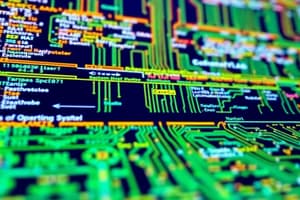Podcast
Questions and Answers
What is the primary function of the memory management component in an operating system?
What is the primary function of the memory management component in an operating system?
- To manage input/output operations
- To execute instructions and perform calculations
- To provide access control and security
- To allocate and deallocate memory for programs (correct)
Which type of computer architecture uses separate buses for data and instructions?
Which type of computer architecture uses separate buses for data and instructions?
- CISC Architecture
- Von Neumann Architecture
- Harvard Architecture (correct)
- RISC Architecture
What is the main difference between a single-user, single-tasking operating system and a multi-user, multi-tasking operating system?
What is the main difference between a single-user, single-tasking operating system and a multi-user, multi-tasking operating system?
- The type of input/output devices supported
- The type of processor used in the system
- The amount of memory available in the system
- The number of users that can access the system (correct)
Which input device is used to input images and documents?
Which input device is used to input images and documents?
What is the primary function of the CPU in a computer system?
What is the primary function of the CPU in a computer system?
Which type of interface transmits data one bit at a time?
Which type of interface transmits data one bit at a time?
What is the primary function of an operating system's security component?
What is the primary function of an operating system's security component?
Which output device is used to display video and graphics?
Which output device is used to display video and graphics?
Flashcards are hidden until you start studying
Study Notes
Operating Systems
- Definition: A software that manages computer hardware resources and provides common services to computer programs
- Functions:
- Process Management: creates, runs, and manages processes
- Memory Management: allocates and deallocates memory for programs
- File Management: provides access to file systems
- Input/Output Management: manages input/output operations
- Security: provides access control and protects against unauthorized access
- Types:
- Single-User, Single-Tasking (e.g. MS-DOS)
- Single-User, Multi-Tasking (e.g. Windows, macOS)
- Multi-User, Multi-Tasking (e.g. Linux, Unix)
Computer Architecture
- Definition: The design and organization of a computer's internal components
- Components:
- CPU (Central Processing Unit): executes instructions
- Memory (RAM): temporary storage for data and programs
- Storage (HDD, SSD): permanent storage for data and programs
- Input/Output Devices: interfaces for user interaction
- Types:
- Von Neumann Architecture: uses a single bus for data and instructions
- Harvard Architecture: uses separate buses for data and instructions
- RISC (Reduced Instruction Set Computing): uses a simplified instruction set
- CISC (Complex Instruction Set Computing): uses a complex instruction set
Input/Output Devices
- Definition: Hardware components that allow users to interact with a computer
- Types:
- Input Devices:
- Keyboard: inputs text and commands
- Mouse: inputs cursor movements and clicks
- Scanner: inputs images and documents
- Microphone: inputs audio
- Output Devices:
- Monitor: displays video and graphics
- Printer: outputs printed documents
- Speaker: outputs audio
- Plotter: outputs graphical plots
- Input Devices:
- Interfaces:
- Serial: transmits data one bit at a time
- Parallel: transmits data multiple bits at a time
- USB (Universal Serial Bus): a standardized interface for peripherals
- HDMI (High-Definition Multimedia Interface): a standardized interface for audio and video
Operating Systems
- Manages computer hardware resources and provides common services to computer programs
- Performs process management, creating, running, and managing processes
- Manages memory allocation and deallocation for programs
- Provides access to file systems through file management
- Manages input/output operations and provides security features
- Single-user, single-tasking OS examples: MS-DOS
- Single-user, multi-tasking OS examples: Windows, macOS
- Multi-user, multi-tasking OS examples: Linux, Unix
Computer Architecture
- Refers to the design and organization of a computer's internal components
- Consists of CPU, memory, storage, and input/output devices
- CPU executes instructions, memory provides temporary storage, and storage provides permanent storage
- Input/output devices enable user interaction
- Von Neumann architecture uses a single bus for data and instructions
- Harvard architecture uses separate buses for data and instructions
- RISC architecture uses a simplified instruction set
- CISC architecture uses a complex instruction set
Input/Output Devices
- Enable user interaction with a computer
- Input devices include keyboard, mouse, scanner, and microphone
- Output devices include monitor, printer, speaker, and plotter
- Serial interface transmits data one bit at a time
- Parallel interface transmits data multiple bits at a time
- USB is a standardized interface for peripherals
- HDMI is a standardized interface for audio and video
Studying That Suits You
Use AI to generate personalized quizzes and flashcards to suit your learning preferences.




